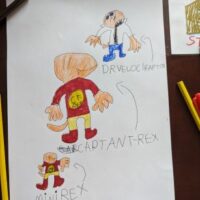Margot and Bricheve








Paris 1942 Paris in Summer would have been a beautiful sight if it was not for the German soldiers and the police lurking on every corner...
On the 30th of March 1811, a Napoleon decree declared that all “found and poor orphaned” children of Paris were to be placed with rural families:...
Previously on Captain T-Rex: So Captain had met his sidekick Mini-Rex and they protected the innocents! Dr Velociraptor was always trying his antics but Captain T-Rex...
When my son was little he has difficulties settling down at night. We use to do this little visualisation exercise to calm him down or fill...
Outline of K. 9 Story A super hero defending the multiverse against evil. Main character: Multiverse God A short hair non-binary character. wears the milky way...
a state preschool but the class was experimental. The aim was to introduce the Montessori education methodology to the mainstream preschool system in the region. The...
Key points: Overall, crafting captivating stories requires attention to character development, genre understanding, conflict resolution, immersive settings, emotional writing, and a well-crafted ending. Enjoy the process...
Do you remember Captain T-Rex part 1? Now it is time for part 2 ! Dr Velociraptor survived the meteor explosion! And he said: “I’ll get...
No swears in this story. Millions of years ago a T-Rex was walking to T-Rex school when all of the sudden a radioactive meteor hit him....